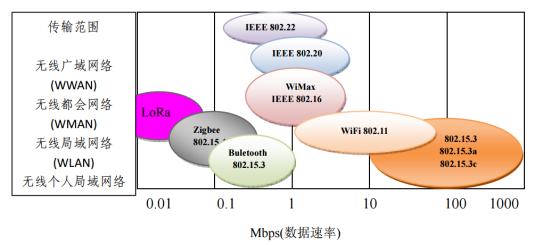LoRa is a technology specifically designed for radio spread spectrum modulation and demodulation, using communication carriers below 1GHz to achieve ultra-low power consumption and long-distance communication. LoRa is a technology that integrates spectrum spread communication technology with GFSK modulation technology. It uses an extraordinary spread spectrum technology, which allows different terminals in the network to use different spread spectrum sequences and transmit data at the same frequency without mutual interference.
Wireless technology is currently one of the most important communication technologies. Wireless communication technology has emerged in almost all fields of electronic products. At present, there are various wireless communication technologies for global short/near/medium distance standards. The main wireless communication technologies on the market include WLAN (Wireless Local Area Network), WWAN (Wireless Wide Area Network), WMAN (Wireless Metropolitan Network), WPAN (Wireless Personal Area Network), and their transmission rates are shown in Figure 1:

Figure 1
There are many types of wireless communication technologies in the Internet of Things, mainly divided into two categories: one is short range communication technologies such as Zigbee, WiFi, Bluetooth, Z-wave, etc; Another type is LPWAN (Low Power Wide Area Network), which is a wide area network communication technology.
LPWAN can be further divided into two categories: one is LoRa, SigFox, and other technologies that operate on unauthorized spectrum; The other type is 3G/4G cellular communication technology supported by 3GPP, such as EC-GSM, LTE Cat-m, NB IoT, etc., which operates under authorized spectrum.
From the analysis and comparison of the above data, it can be roughly concluded that LoRa and NB IoT are very suitable for industrial control fields that require a certain scale of networking, have strong requirements for low power consumption and long-distance, high security, and small data volume.
2. Technical characteristics and application direction of LoRa
LoRa is an emerging Sub-1G wireless communication technology. Compared with ordinary small wireless devices, it has lower power consumption, longer communication distance, and better communication reliability. Compared with long-distance wireless communication technologies such as GSM and CDMA, the complexity and cost of their communication network are extremely low, but the disadvantage is that the communication rate is relatively low. LoRa can be expanded in fields such as sensor networks, industrial sites, home monitoring, security systems, and the Internet of Things.
2.1 Technical characteristics of LoRa
The technical characteristics of LoRa can be summarized in the following three points:
2.1.1 greatly improves the sensitivity of reception and reduces power consumption
The link budget of up to 164dB allows for a communication distance of up to 15 kilometers (depending on the environment). Its receiving current is only 10mA, and its sleep current is 200nA, which greatly reduces the power consumption of the device.
2.1.2 The gateway/concentrator based on this technology supports parallel processing of multi-channel and multi data rates, with a large system capacity
A gateway is a bridge between a node and an IP network (via 3G/4G or Ethernet). Each gateway can handle 5 million communications between nodes per day (assuming 10 Bytes are sent each time, with a network occupancy rate of 10%). If the gateway is installed at the location of an existing mobile communication base station with a transmission power of 20dBm (100mW), it can cover about 2 kilometers in densely built urban environments, and up to 10 kilometers in lower density suburbs.
2.1.3 Terminal and concentrator/gateway based systems can support ranging and positioning
The measurement of distance by LoRa is based on the air transmission time of the signal rather than the traditional RSSI (Received Signal Sterngth Ind-icaTIon), while positioning is based on the measurement of the air transmission time difference between multiple points (gateways) and one point (node). Its positioning accuracy can reach 5m (assuming a range of 10km).
2.2 Key features and advantages of LoRa
2.3 Application Fields of LoRa
It is precisely due to the key characteristics of LoRa that LoRa technology is very suitable for IoT applications that require low power consumption, long distances, large connections, and location tracking, such as intelligent buildings, intelligent meter reading, intelligent parking, vehicle tracking, pet tracking, smart agriculture, smart industry, smart cities, smart communities, and other applications and fields.
3. Development Trends of LoRa Wireless Transmission Solutions
With the global advancement of smart cities, the importance of low-power wide area network technology is becoming increasingly important. Smart city technology is a way for governments and cities to provide sustainable services to effectively meet the influx of urban population. Semtech's LoRa technology and Low Power Wide Area Network (LPWAN) based on the LoRaWAN protocol provide an intelligent sensing and control infrastructure, enabling cities to collect and analyze data from thousands of connected devices in a simplified and effective manner, in order to make decisions about the services they need to provide.
Accelerated deployment of LoRa networks both domestically and internationally:
Due to its ease of construction and deployment, LoRa network has become the most widely used IoT dedicated network communication technology. Multiple standards or alliances have emerged internationally, such as NB IoT, LoRa, and Weightless.
At present, the LoRa network has been piloted or deployed in multiple parts of the world. As of the latest released data, 17 countries have publicly announced network construction plans, and more than 120 urban areas have LoRa networks in operation, such as the United States, France, Germany, Australia, India, and other countries. The Netherlands, Switzerland, South Korea, and other countries are also deploying or planning to deploy LoRa networks covering the whole country. Mainstream telecom operators from various countries, such as Orange, KPN, SK, TATA, SoftBank, Senet, Comcast, etc., have chosen LoRa to build IoT dedicated networks, forming IoT standard specifications originating from LoRaWAN and promoting them on a large scale.
Contact: Qui
Phone: 18146178586
Tel: 18146178586
Email: qui@zonewu.com
Add: 1501-3, Building F03, Phase III, Software Park, Jimei District, Xiamen City, Fujian Province, China
